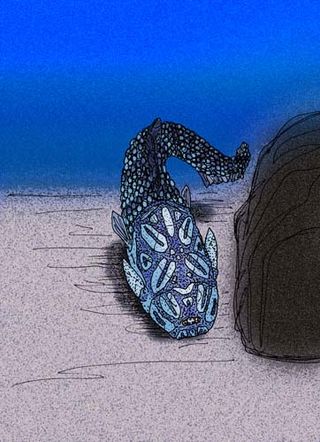
Mizia is a genus of primitive antiarch placoderm found in Emsian-aged marine strata of Early Devonian China.

Protaspididae is an extinct family of pteraspidid heterostracan agnathans. Fossils of the various genera are found in early Devonian-aged marine strata. Protaspidids were once thought to represent a transitional form between the Pteraspididae and the Psammosteida, bearing the broad head shield shape of the latter, due to a more benthic (bottom-dwelling) existence, but recent phylogenical comparisons demonstrate that the protaspidids are actually highly derived pteraspidids, and that the anchipteraspidids, the most primitive of pteraspidids, are the sister-group of the Psammosteids.
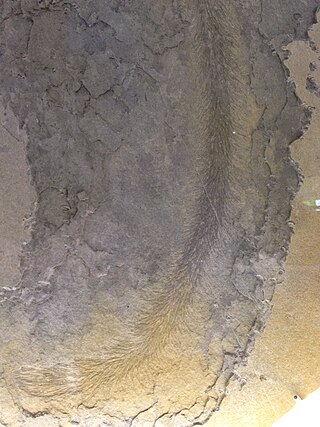
Baragwanathia is a genus of extinct lycopsid plants of Late Silurian to Early Devonian age, fossils of which have been found in Australia, Canada, China and Czechia. The name derives from William Baragwanath who discovered the first specimens of the type species, Baragwanathia longifolia, at Thomson River.
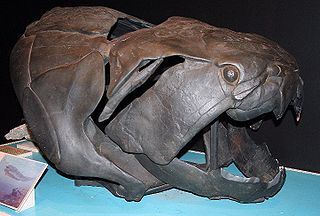
Dunkleosteidae is an extinct family of arthrodire placoderms that lived during the Devonian period. The gigantic apex predator Dunkleosteus terrelli is the best known member of this group.
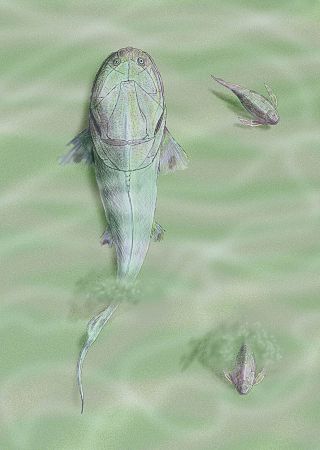
Homosteus is a genus of flattened arthrodire placoderm from the Middle Devonian. Fossils are found primarily in Eifelian-epoch aged strata of Europe, Canada, Greenland, and Estonia. All of the species had comparatively large, flattened heads with, as suggested by the upward opening orbits, upward-pointing eyes. These adaptations suggest that the various species were benthic predators. A study on Titanichthys, in contrast, suggests that species of Homosteus may have been filter-feeders instead.
Yarravia is a genus of extinct vascular plants mainly known from fossils found in Victoria, Australia. Originally the rocks in which they were found were considered to be late Silurian in age; more recently they have been found to be Early Devonian. Specimens consist only of incomplete leafless stems, some of which bore groups of spore-forming organs or sporangia which were fused, at least at the base.
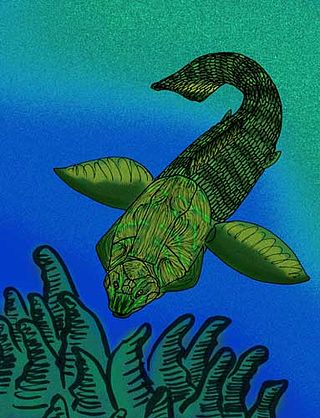
Holonematidae is an extinct family of relatively large arthrodire placoderms from the Early to Late Devonian. Almost all fossil specimens are of armor fragments, though, all have distinctive ornamentation, often of unique arrangements and patterns of tubercles, that are diagnostic of the family. The trunkshield is very elongated, giving the armor an overall "barrel" like appearance.

Xiangshuiosteus wui is an extinct monospecific genus of brachythoracid arthrodire placoderm from the Late Emsian stage of the Early Devonian epoch, discovered in Wuding County of Yunnan province, China. It has recently been reassessed as a dunkleosteid.

Homostiidae is a family of flattened arthrodire placoderms from the Early to Middle Devonian. Fossils appear in various strata in Europe, Russia, Morocco, Australia, Canada and Greenland.
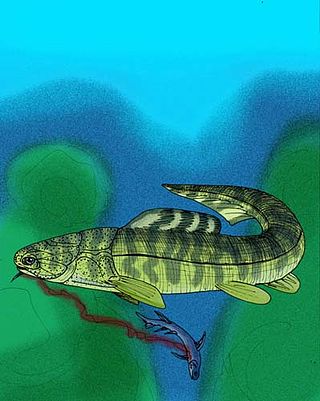
Buchanosteidae is a family of arthrodire placoderms that lived from the Early to Middle Devonian. Fossils appear in various strata in Russia, Central Asia, Australia, and China.

Coccosteidae is a family of arthrodire placoderms from the Early to Late Devonian. Fossils appear in various strata in Europe, North America and China.
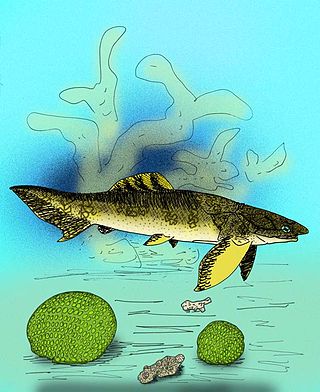
Arenipiscis westolli is an extinct buchanosteid arthrodire placoderm. Its fossils have been found in Emsian-aged marine strata of New South Wales, Australia.

Errolosteus goodradigbeensis is an extinct buchanosteid arthrodire placoderm. Its fossils have been found in Emsian-aged marine strata of New South Wales, Australia.
Exutaspis megista is an extinct, "giant" buchanosteid arthrodire placoderm. Its fossils have been found in the Late Emsian-aged marine strata of the Jiucheng and Haikou Formations in Wuding, Yunnan.

Taemasosteus is an extinct genus of arthrodire placoderm. Its fossils have been found in Emsian-aged marine strata in New South Wales, Australia. It contains two species, T. novaustrocambricus, and T. maclartiensis.

Goodradigbeeon is an extinct genus of buchanosteid arthrodire placoderm. Its fossils have been found in Emsian-aged marine strata from the Taemas-Wee Jasper reef of New South Wales, Australia and the type species is G. australianum.

Narrominaspis longi is an extinct buchanosteid arthrodire placoderm. Its fossils, and those of the acanthothoracid, Connemarraspis, have been found in the late Lochkovian-aged marine strata of the Connemarra Formation in Australia.

Burrinjucosteus asymmetricus is an extinct buchanosteid arthrodire placoderm. Its fossils have been found in Emsian-aged marine strata of New South Wales, Australia.
Microbrachiidae is an extinct family of tiny, advanced antiarch placoderms closely related to the bothriolepidids.
Microbrachius is an extinct genus of tiny, advanced antiarch placoderms closely related to the bothriolepids. Specimens range in age from the Lower Devonian Late Emsian Stage to the Middle Devonian Upper Givetian Stage. They are characterized by having large heads with short thoracic armor of an average length of 2–4 cm. There are patterns of small, but noticeable tubercles on the armor, with the arrangement varying from species to species. Specimens of Microbrachius have been found in Scotland, Belarus, Estonia, and China.























